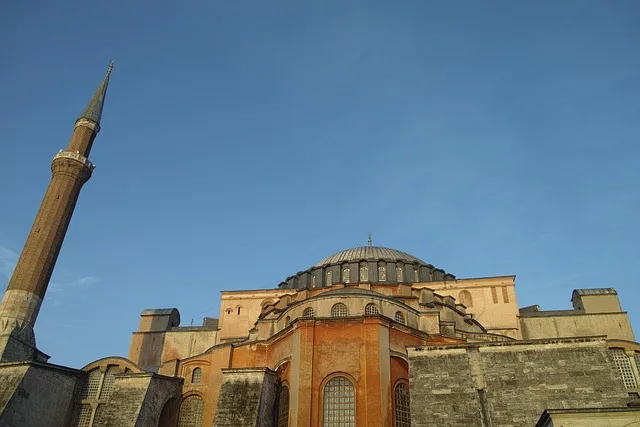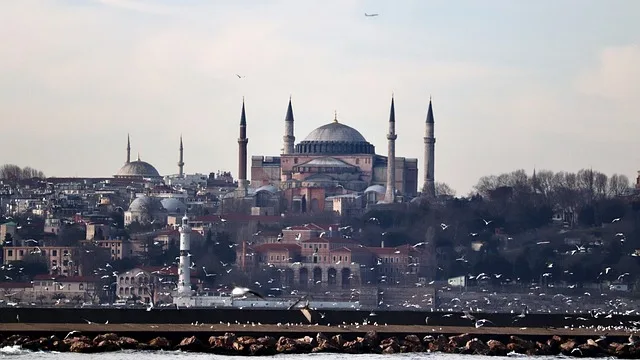As you walk through its massive doors, the sheer scale of the dome above you is nothing short of awe-inspiring. It’s like standing beneath the sky itself, with light streaming through the windows, casting a divine glow on the intricate mosaics and calligraphy that adorn the walls. Each detail is a brushstroke in the grand painting of Istanbul’s history, inviting you to ponder the lives that have passed through this sacred space.
But what makes Masjid Aya Sophia truly special is its role as a cultural bridge. It’s not just a building; it’s a testament to the resilience and adaptability of faith. Can you imagine the countless prayers that have echoed within its walls? The stories of devotion, struggle, and unity that have unfolded here? It’s a place where the past and present collide, reminding us of our shared humanity.
Visiting Masjid Aya Sophia is like embarking on a journey through time. You can almost hear the whispers of scholars and artists who once roamed its halls, each leaving their mark on this iconic structure. It’s a living museum, a vibrant heart that continues to beat with the spirit of Istanbul’s Islamic heritage, inviting everyone to explore its depths and discover the beauty of its history.
Masjid Aya Sophia: A Timeless Testament to Istanbul’s Islamic Heritage
When you walk through its grand entrance, you’re greeted by soaring domes and intricate mosaics that seem to dance in the light. It’s like stepping into a storybook where every corner reveals a new chapter. The vastness of the interior is awe-inspiring, making you feel both small and connected to something much larger than yourself. Can you picture the countless worshippers who have filled this space, their voices rising in unison, creating a symphony of faith?
The Masjid Aya Sophia stands as a testament to resilience and adaptation. It’s a symbol of how cultures can blend and evolve, much like a beautiful tapestry woven from different threads. The stunning calligraphy that adorns its walls speaks volumes about the artistry and devotion of those who came before us. Each stroke tells a story, inviting you to pause and reflect on the spiritual journey that has unfolded here.
From Cathedral to Mosque: The Transformative Journey of Aya Sophia
Originally built in 537 AD as a cathedral, Aya Sophia was the heart of the Byzantine Empire. Picture the vibrant mosaics glimmering in the sunlight, the air filled with the sound of hymns echoing off the massive dome. It was a place of worship, a symbol of Christian faith, and a masterpiece of architecture. But as history unfolded, so did its purpose.
Fast forward to 1453, when the Ottomans swept in, and Aya Sophia underwent a dramatic transformation. Imagine the shift in atmosphere as the church bells were replaced by the call to prayer. The stunning mosaics were covered, and minarets rose high into the sky, marking a new era. It became a mosque, a place where the faithful gathered, and the air was filled with the rich sounds of Islamic prayers.
But the story doesn’t end there. In 1935, Aya Sophia opened its doors as a museum, inviting people from all walks of life to marvel at its beauty. It became a bridge between cultures, a testament to the resilience of history. Today, it stands as a UNESCO World Heritage site, drawing millions who are eager to witness its grandeur.
Aya Sophia: Where Byzantine Splendor Meets Islamic Majesty
Originally built as a cathedral in 537 AD, Aya Sophia was the epitome of Byzantine architecture, boasting a massive dome that seems to float above the nave. It’s as if the heavens themselves are cradling this magnificent structure. The intricate mosaics, shimmering with gold and vibrant colors, depict scenes that have captivated visitors for centuries. Can you imagine the artisans who painstakingly crafted these images, pouring their souls into every tile?
Fast forward to 1453, and the Aya Sophia transformed into a mosque, embracing Islamic artistry. The addition of minarets and calligraphic inscriptions brought a new layer of beauty, blending seamlessly with the existing grandeur. It’s like watching a beautiful duet unfold, where each note complements the other, creating a harmonious symphony of cultures.
Walking through its vast halls, you can almost feel the energy of the countless worshippers who have gathered here over the centuries. The play of light filtering through the windows creates an ethereal atmosphere, making you feel as if you’re in a dream. Isn’t it fascinating how a single building can embody such diverse spiritual journeys?
Aya Sophia isn’t just a monument; it’s a living testament to the resilience of art and faith. It invites you to ponder the stories etched in its walls and the myriad of emotions it has witnessed. Each visit feels like a new chapter in an ongoing saga, reminding us of the beauty that arises when cultures collide.
Exploring the Spiritual Significance of Masjid Aya Sophia in Modern Turkey
Originally built as a cathedral, Aya Sophia has seen the ebb and flow of empires, transitioning from a Christian basilica to an Islamic mosque, and now a museum. This journey reflects the rich tapestry of Turkey’s cultural and spiritual identity. Each mosaic and calligraphic inscription tells a tale, inviting you to ponder the layers of belief that have shaped this iconic structure.
Have you ever felt a chill run down your spine in a place steeped in history? That’s the magic of Aya Sophia. It’s not just about the stunning architecture; it’s about the energy that fills the air. Visitors often describe a sense of peace and connection, as if the walls themselves are alive with the prayers of countless souls who have sought solace within.

In today’s world, where spirituality can sometimes feel lost in the hustle and bustle, Aya Sophia stands as a beacon. It encourages us to reflect on our own beliefs and the shared human experience. Whether you’re a devout follower or a curious traveler, stepping into this sacred space can spark a profound sense of wonder.

So, next time you find yourself in Istanbul, take a moment to absorb the spiritual essence of Aya Sophia. Let its history wash over you, and who knows? You might just leave with a renewed sense of purpose and connection to something greater than yourself.
Frequently Asked Questions
How has the function of Aya Sophia changed over time?
The structure has transitioned through various roles, originally serving as a cathedral, then a mosque, and later a museum. Each phase reflects the cultural and religious shifts in the region, impacting its architecture, art, and public accessibility.
What architectural features make Aya Sophia unique?
The structure is renowned for its massive dome, innovative use of light, and harmonious blend of Byzantine and Ottoman architectural elements. Its vast interior space, supported by pendentives, creates an awe-inspiring atmosphere, while intricate mosaics and calligraphy showcase its historical significance and artistic heritage.
Can visitors enter Masjid Aya Sophia, and what are the visiting hours?
Visitors are allowed to enter Masjid Aya Sophia, which is a significant historical and architectural site. The visiting hours may vary, so it is advisable to check the official website or local resources for the most current information before planning your visit.
What role does Aya Sophia play in modern Istanbul’s culture?
Aya Sophia serves as a symbol of Istanbul’s rich cultural heritage, blending Byzantine and Ottoman influences. It functions as a museum and a mosque, attracting millions of visitors annually. The site embodies the city’s historical significance and continues to inspire art, architecture, and spirituality in modern Istanbul.
What is the historical significance of Masjid Aya Sophia?
Masjid Aya Sophia, originally a cathedral, later a mosque, and now a museum, symbolizes the architectural and cultural fusion of Byzantine and Ottoman empires. Its historical significance lies in its role as a center of Christianity and later Islam, reflecting the religious and political transformations in the region. The structure is renowned for its massive dome and stunning mosaics, representing advancements in engineering and artistry of its time.

